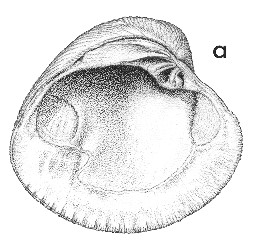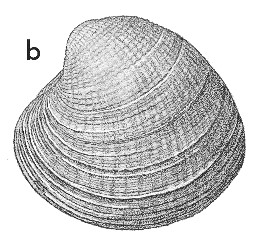
Revised descriptions of New Zealand Cenozoic Mollusca from Beu and Maxwell (1990)

 | Revised descriptions of New Zealand Cenozoic Mollusca from Beu and Maxwell (1990) | 
|
  (Pl. 41a): GS1164, R22/f6348, Tewkesbury Formation, Nukumaru Beach, Wanganui, Nukumaruan (GNS) |
  (Pl. 41b): GS1164, R22/f6348, Tewkesbury Formation, Nukumaru Beach, Wanganui, Nukumaruan (GNS) |
Beu & Maxwell (1990): Chapter 15; p. 313; pl. 41 a,b.
Synonymy: Venus stutchburyi Gray ms, Wood 1828, fig. 4; Venus zelandica Quoy & Gaimard 1835, p. 522; Venus dieffenbachi Gray 1843, p. 250; Chione macleayana Tenison Woods 1879, p. 38 (see Hedley 1902, p. 77); Chione crassitesta Finlay 1924b, p. 478; Chione (Austrovenus) aucklandica Powell 1932a, p. 68; Austrovenus stutchburyi of Fischer-Piette & Vukadinovic 1977, and of Jones 1979, p. 157; Chione stutchburyi; Austrovenus stutchburyi forma crassitesta Beu & Maxwell 1990, p. 313, pl. 41a, b.
Type species of Austrovenus Finlay, 1926
Classification: Veneridae: Chioninae?
Description: Moderate-sized for family (15-65 mm long, rarely to 90 mm), exceedingly variable in shell thickness, shape, inflation, height, and sculptural prominence; subcircular, weakly trigonal, or elongate-oval in outline, with umbo low to strongly protruding. Most forms inflated and thick-shelled; one of very few New Zealand Veneridae with both radial and commarginal sculpture prominent (commarginal lamellae are relatively weak on some forms from low-salinity environments). Radial costae low, wide, and flat-topped; becoming weak near ventral margin of large shells. Commarginal lamellae thin, moderately prominent, widely spaced, regular and prominent near umbo but irregular near ventral margin of large specimens. Interior of ventral margin complexly crenulate, with 2 orders of crenulating ridges. Hinge wide, with long, prominent ligamental nymph, and escutcheon defined only by an unsculptured area above nymph; right valve with 2 thick, bifid cardinal teeth, thin posterior cardinal tooth, and short, knob-like anterior lateral tooth; left valve with 2 thick, bifid cardinal teeth, weak posterior lateral ridge, and only anterior lateral socket. Adductor scars deeply impressed, anterior slightly narrower than posterior. Pallial sinus short, narrow, triangular.
Comparison: The taxonomy of Austrovenus has been poorly understood. Beu & Maxwell (1990) illustrated the form that Finlay (1924b) regarded as the "species" A. crassitesta, and that some authors have thought to be a restricted Nukumaruan taxon (Marwick 1927, p. 621). This is, however, the most common form in Haweran shellbeds along the Wanganui-South Taranaki coast, is Haweran at its type locality, and can be matched in modern faunas. Beu (2006, pp. 278-287) discussed the variation, and demonstrated a geographical cline in both shape and size with latitude over New Zealand at present; the largest and most elongate specimens occur at the Auckland Islands, whereas the smallest and tallest specimens occur in northern Northland. This variation indicates that all named forms are part of the single species A. stutchburyi. The only exceptions are A. tamakiensis (Waipipian, Otahuhu Brewery well), which is low, weakly sculptured, and with a relatively prominent escutcheon, and A. northlandica Eagle (1999, p. 160) (Otaian, Early Miocene, Waitakere Group, Hunua ranges, SE Auckland), which is smaller and more elongate-oval than all other species. The genus is first known in Waitakian rocks (a near-shore faunule in the Mataura River, Southland, near Brydone) when it was represented by very small, antero-posteriorly short, upright shells sculptured more coarsely than A. stutchburyi. However, records from pre-Wanganui Series rocks are extremely scarce.
Jones (1979) found the anatomy of Austrovenus stutchburyi abundantly distinct from that of American Chione species, proving that the resemblance in shell characters is due to convergence. Beu (2004, p. 182) pointed out the much greater similarity to South American species assigned to Ameghinomya Ihering, 1907, suggesting that Austrovenus is most closely related to Ameghinomya.
Distribution: Opoitian(?)-Recent. Recent, New Zealand (types of Venus stutchburyi, Venus zelandica, Venus dieffenbachi; ?and of Chione macleayana, either an introduced Tasmanian specimen or a wrongly localised New Zealand one); Recent, Auckland Islands, subantarctic (type of Chione aucklandica); Clifton, Cape Kidnappers, Hawke's Bay (from the young "Austrovenus beds" high in the Haweran coastal cliff section east of Clifton — probably from the Te Awanga beds in Clifton Gully or Gordon Gully inland from the coast section), type of Chione crassitesta. Austrovenus stutchburyi is the superabundant edible "cockle", living partially buried (the posterior end of the shell protrudes, and so most specimens are bored by the polychaete Polydora) in sand, gravel, or muddy sand in the low-tidal zone of New Zealand's present-day estuaries and enclosed bays, varying greatly with the salinity, substrate and food supply. It is the dominant infaunal bivalve in the upper parts of estuaries, and in brackish streams pure populations (or at some places with Limnoperna securis and Melanopsis trifasciata) can consist of shells of very small maximum size, perhaps only 15 mm long. Faunules consisting of 100% A. stutchburyi (or nearly so) are encountered in many sand and mud flats in the outer parts of estuaries, with shells in the size range of 20-50 mm long. Large shells (40-60 mm long) are found abundantly in the outer parts of bays with higher salinity and more diverse faunas (including such bivalves as Dosinia subrosea and Ruditapes largillierti). However, the genus is unknown in fully marine situations (with such bivalves as Dosinia anus or Crassula aequilatera). Many fossil estuarine faunules from Nukumaruan, Castlecliffian and (in particular) Haweran rocks contain 100% A. stutchburyi, clearly implying deposition in an estuary. However, fossil assemblages are also often encountered that consist of A. stutchburyi (with or without other estuarine taxa) as well as open-ocean taxa such as Dosinia anus; these assemblages seem to represent accumulation in a bay-bar or similar situation, with shells contributed from several environments. A. stutchburyi is certainly one of the most abundant of all late Neogene macrofossils.
Cite this publication as: "A.G. Beu and J.I. Raine (2009). Revised
descriptions of New Zealand Cenozoic Mollusca from Beu and Maxwell (1990). GNS
Science miscellaneous series no. 27."
© GNS Science, 2009
ISBN
978-0-478-19705-1
ISSN 1177-2441
(Included with a PDF facsimile file
copy of New Zealand Geological Survey Paleontological Bulletin 58 in CD version
from: Publications Officer, GNS Science, P.O. Box 30368 Lower Hutt, New
Zealand)